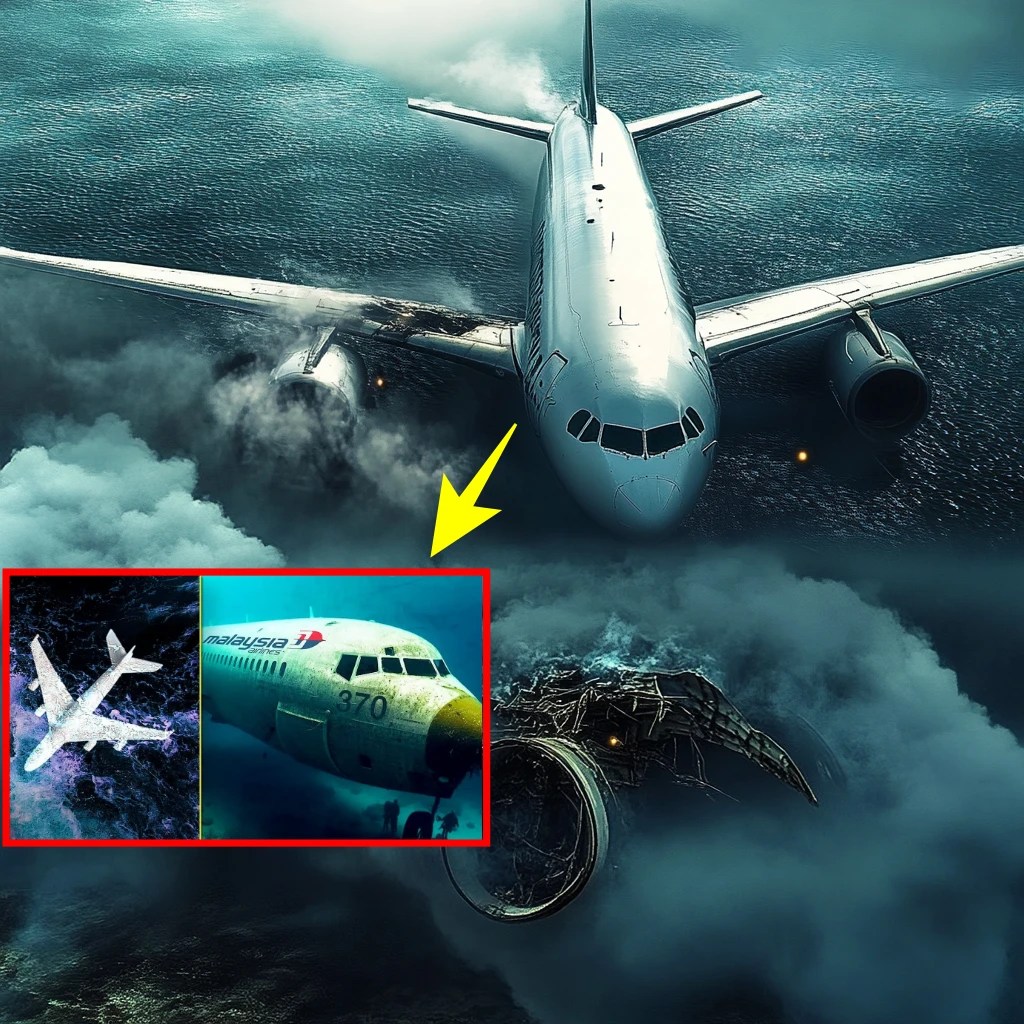🌊 What if the greatest aviation mystery is about to be solved? 🌊
Ten years after Malaysia Airlines Flight MH370 vanished with 239 souls on board, a new clue has emerged from the depths of the Indian Ocean. A scientist claims to have pinpointed the exact spot where the plane may rest—hidden in a place so remote, it’s been called the “perfect hiding place.” Could this be the breakthrough we’ve all been waiting for? Or is it another dead end in a decade-long enigma? 🤔
Dive into the mystery and uncover the latest twist in this haunting story.

On March 8, 2014, Malaysia Airlines Flight MH370 took off from Kuala Lumpur, bound for Beijing with 239 people on board. Less than an hour later, it vanished from radar, leaving behind a trail of questions that have haunted the world for over a decade. No distress call. No clear evidence of mechanical failure. Just a Boeing 777, swallowed by the night, becoming aviation’s greatest unsolved mystery. Now, in 2025, new evidence has sparked fresh hope that the plane’s final resting place may finally be found. But the ocean is vast, and the truth remains elusive.
The Vanishing Act
It was a routine flight. The Boeing 777, registered as 9M-MRO, left Kuala Lumpur at 12:41 a.m., climbing to 35,000 feet. Thirty-nine minutes later, the pilot, Captain Zaharie Ahmad Shah, signed off with air traffic control: “Good Night, Malaysian Three Seven Zero.” That was the last anyone heard from the plane. Its transponder, which broadcasts location data, went silent. Military radar later revealed the plane had made a sharp turn westward, crossing the Malay Peninsula and Andaman Sea before disappearing. Satellite data suggested it flew for another seven hours, likely into the southern Indian Ocean, but its precise path and fate remain unknown.
Theories have swirled ever since. Was it a hijacking? A mechanical failure? A deliberate act by the pilot? The absence of a distress call, ransom demand, or signs of technical issues deepened the enigma. Debris, including a flaperon found on Réunion Island in 2015, confirmed the plane ended in the Indian Ocean, but the main wreckage has never been located despite a $150 million search effort—the most expensive in aviation history.
A New Lead in the Deep
Fast forward to 2024, and an Australian scientist named Vincent Lyne, from the University of Tasmania’s Institute for Marine and Antarctic Studies, claims to have cracked the case. In a LinkedIn post titled “Mystery of MH370 Solved by Science,” Lyne argues the plane lies in a 6,000-meter-deep “hole” in the Broken Ridge, a treacherous underwater plateau in the southern Indian Ocean. This isn’t just any spot—it’s a rugged, sediment-filled trench surrounded by steep ridges, which Lyne calls the “perfect hiding place.”
His theory challenges the idea that MH370 crashed in an uncontrolled dive after running out of fuel. Instead, he suggests the pilot executed a controlled ditching, similar to Captain Chesley “Sully” Sullenberger’s famous landing on the Hudson River in 2009. Lyne points to damage on the plane’s flaperon and wing fragments, which show clean breaks rather than the mangled wreckage expected from a high-speed impact. He also ties the location to a flight path found on the pilot’s home simulator, a detail dismissed by the FBI in 2014 but now seen as potentially significant.
Lyne’s claim isn’t without skeptics. Some experts argue the simulator data is inconclusive, and the Broken Ridge’s extreme depth makes searching there a logistical nightmare. Yet, his pinpointed location—where the longitude of Penang airport intersects with the simulator’s flight path—has reignited debate and drawn attention from those desperate for answers.
WSPR: A Signal in the Noise?
Another intriguing development comes from aerospace engineer Richard Godfrey, who has spent years analyzing Weak Signal Propagation Reporter (WSPR) data—radio signals used by amateurs that can detect disturbances caused by aircraft. Godfrey claims to have identified 130 anomalies in WSPR signals over the southern Indian Ocean, mapping a final flight path for MH370 that ends just outside the “seventh arc,” a key search area based on the plane’s last satellite communication.
Working with Professor Simon Maskell from the University of Liverpool, Godfrey is using statistical tools to verify his findings. Not everyone is convinced—some argue WSPR data isn’t reliable for tracking planes—but the approach has gained traction, especially as it aligns with other evidence pointing to the southern Indian Ocean. If validated, this could narrow the search area significantly, offering a more precise target than the 120,000 km² scoured in earlier efforts.
Ocean Infinity’s Renewed Mission
Enter Ocean Infinity, a Texas-based marine robotics company that’s no stranger to the MH370 mystery. In 2018, they searched a 25,000 km² area under a “no find, no fee” contract but came up empty. In early 2025, they launched a new mission, armed with advanced underwater drones and sonar technology, targeting a 15,000 km² zone between 33°S and 36°S. Malaysia’s government, eager for closure, promised a $70 million reward if the wreckage is found.
The search began with promise but was paused in April 2025 due to rough seas and seasonal challenges. Ocean Infinity plans to resume by year-end, using their cutting-edge Armada 78 vessels, which deploy autonomous drones capable of mapping the ocean floor in high resolution. These drones are a game-changer, able to navigate depths previously deemed unreachable. Combined with drift analysis from the University of Western Australia, which suggests the plane lies near 35°S, the mission holds real potential.
The Human Cost
Beyond the science and technology, MH370 is a human tragedy. The 239 passengers and crew came from over a dozen countries, with nearly two-thirds from China. Families have spent a decade in limbo, grappling with grief and unanswered questions. Some, like Li Eryou, who lost his son, express frustration at the lack of direct communication from authorities. Others, like Fuad Sharuji, a former Malaysia Airlines crisis director, note the stigma faced by the pilot’s family amid unproven theories of foul play.
Theories about the pilot, Zaharie Ahmad Shah, have been particularly divisive. Some, like journalist William Langewiesche, argue the disappearance was a deliberate act, possibly involving depressurization to incapacitate passengers. A flight path on Zaharie’s simulator, mirroring MH370’s route, fuels speculation, though his family denies any wrongdoing. Without the wreckage or black box, these remain theories, not facts.
What’s at Stake
Finding MH370 isn’t just about closure for families—it’s about lessons for aviation. The disaster spurred changes, like the 2025 mandate for planes to broadcast their position every minute during distress, but older aircraft like the Boeing 777 aren’t covered. Locating the wreckage could reveal whether human error, mechanical failure, or something else caused the tragedy, potentially preventing future disasters.
The ocean, however, is a formidable adversary. The southern Indian Ocean’s depths, averaging 4 km, are plagued by bad weather and complex currents. Debris drift studies show the plane’s remnants could have scattered across thousands of miles, complicating searches. Yet, the ocean’s cold, dark conditions are ideal for preserving evidence, meaning the black box and wreckage could still hold answers.
A Glimmer of Hope
As 2025 unfolds, the MH370 mystery feels closer to resolution than ever. Lyne’s “perfect hiding place,” Godfrey’s WSPR data, and Ocean Infinity’s high-tech search converge on a shared belief: the plane is out there, waiting to be found. But the ocean keeps its secrets well, and past searches have ended in disappointment. Will this be the year the truth surfaces, or will MH370 remain a ghost in the deep?
For now, the world watches and waits. Families pray for closure. Scientists refine their calculations. And a fleet of drones prepares to scour the abyss. The mystery of MH370 has endured for over a decade, but with new evidence and relentless determination, we may finally be on the cusp of an answer.





